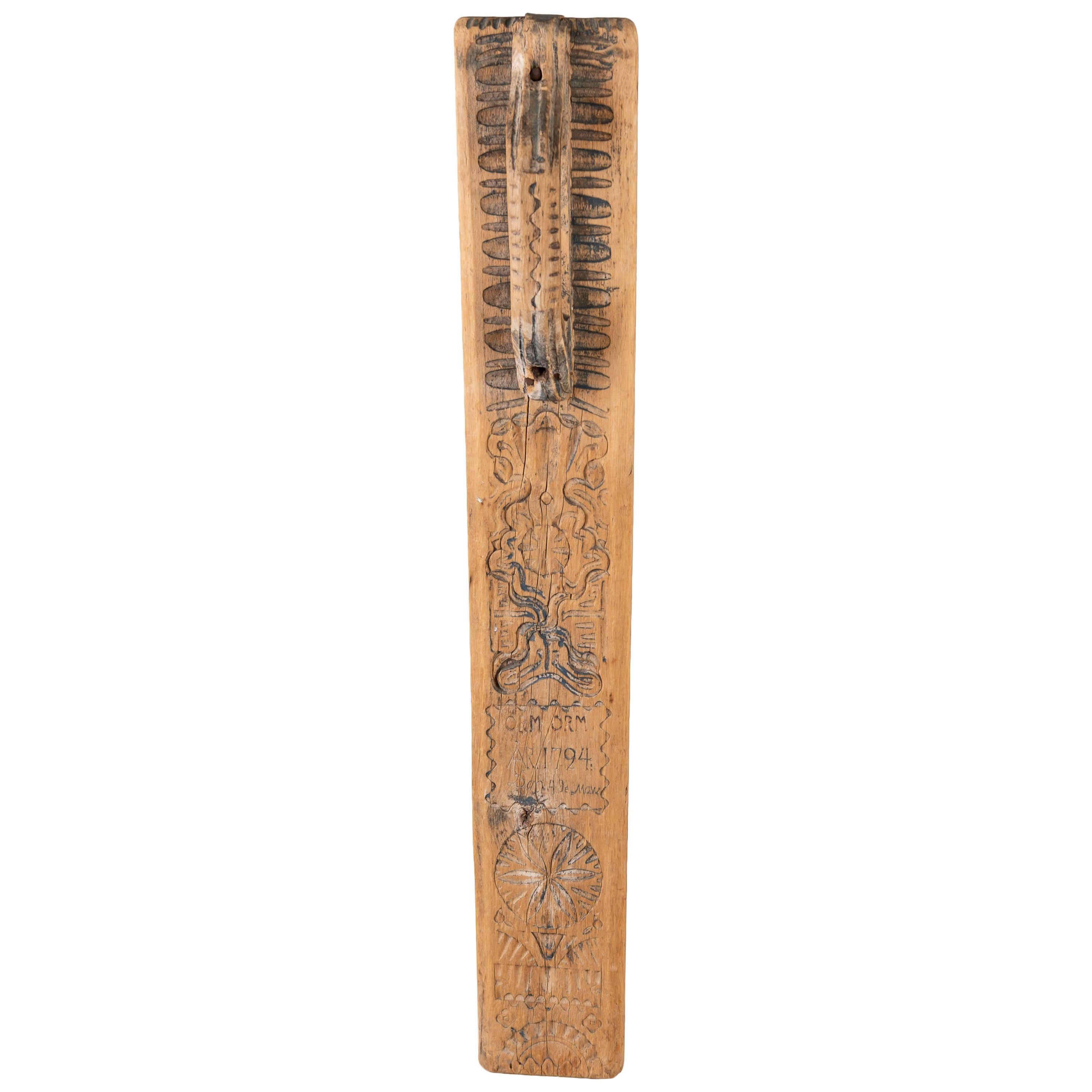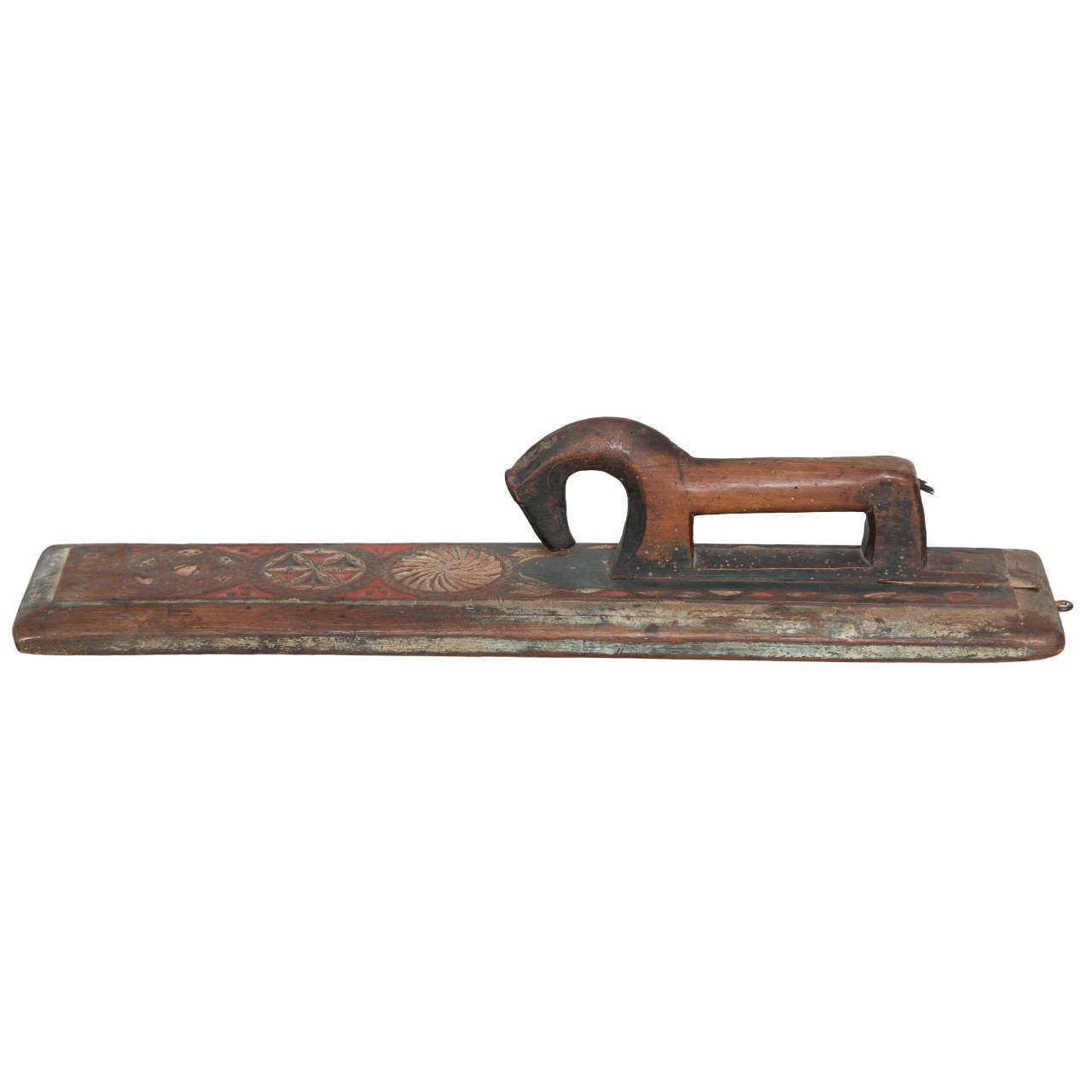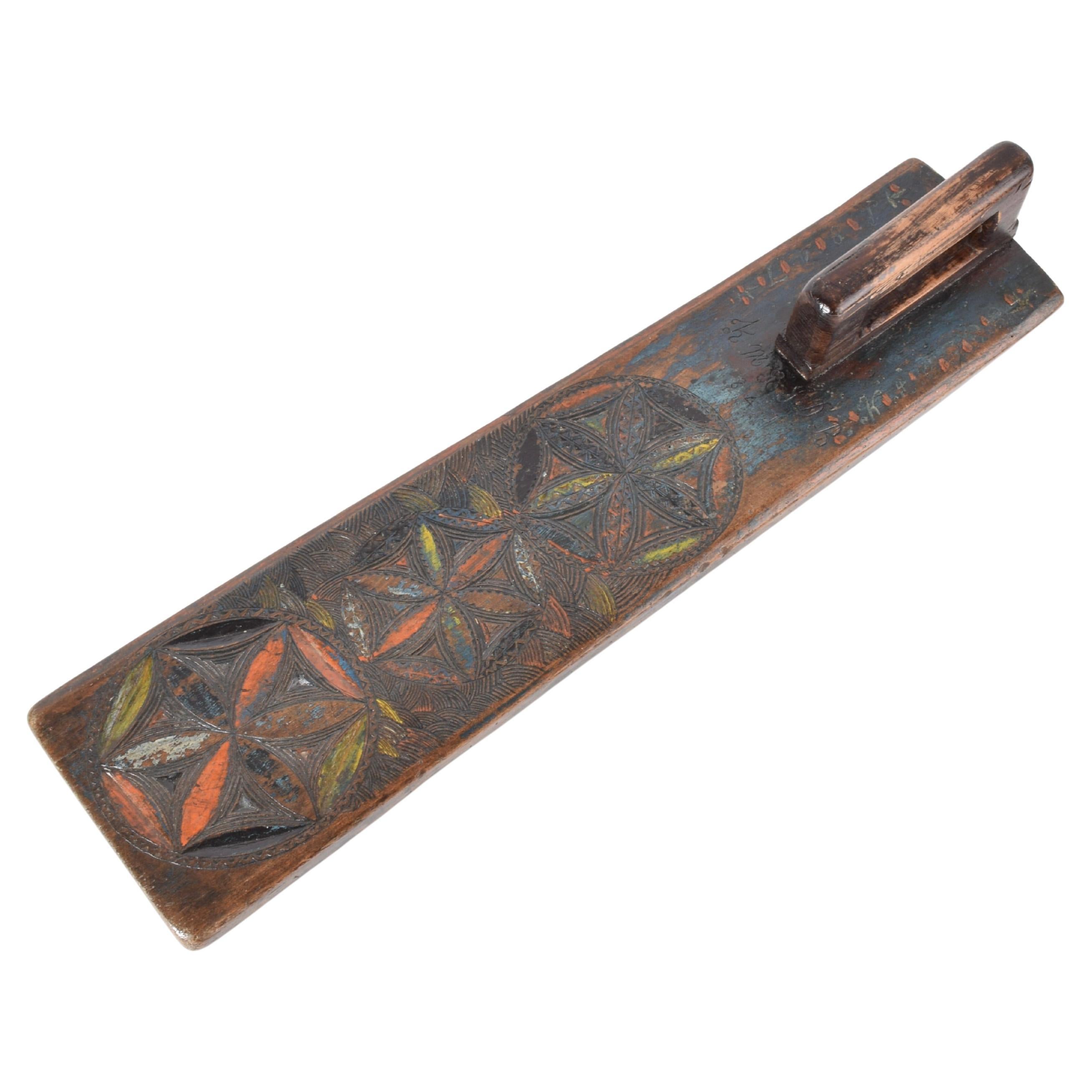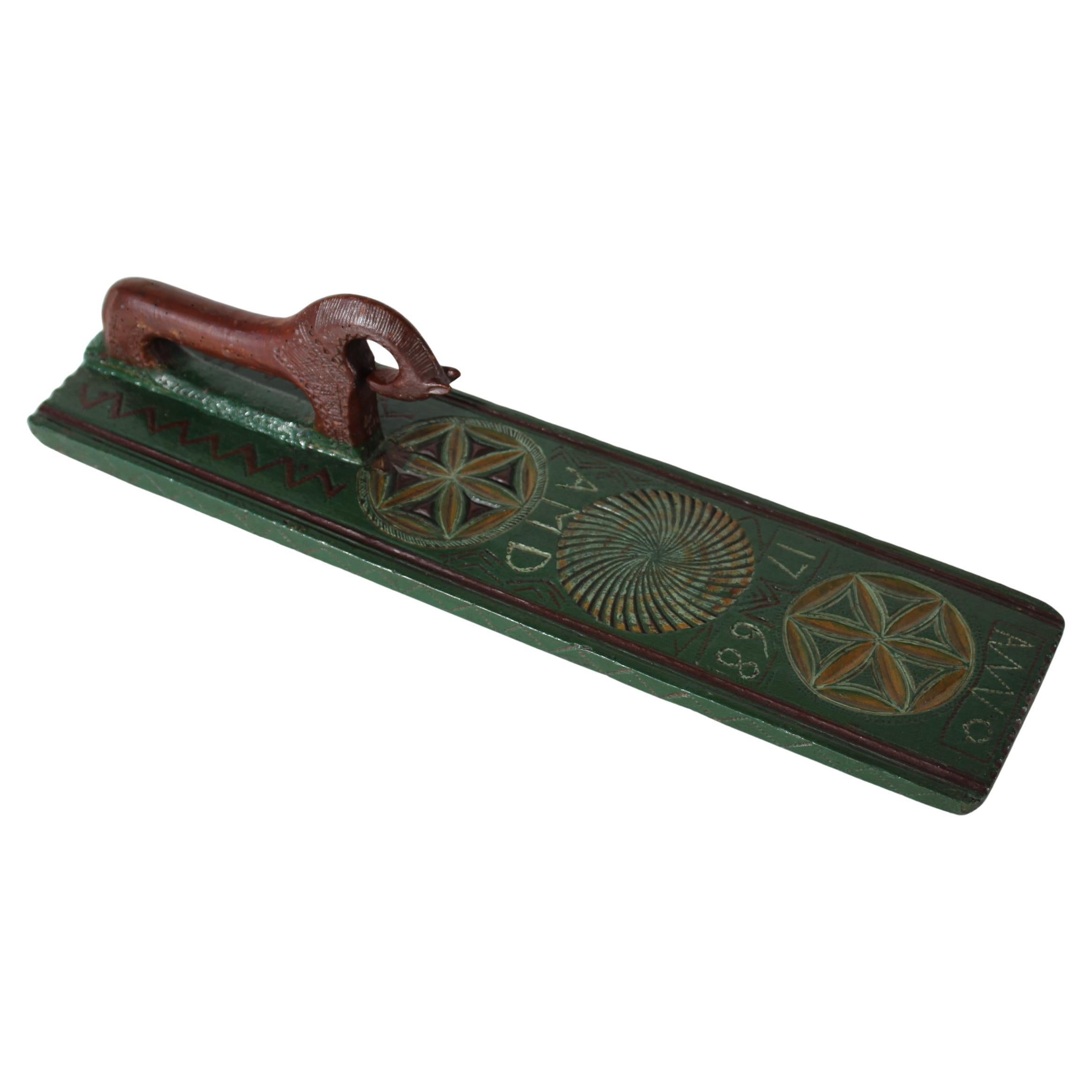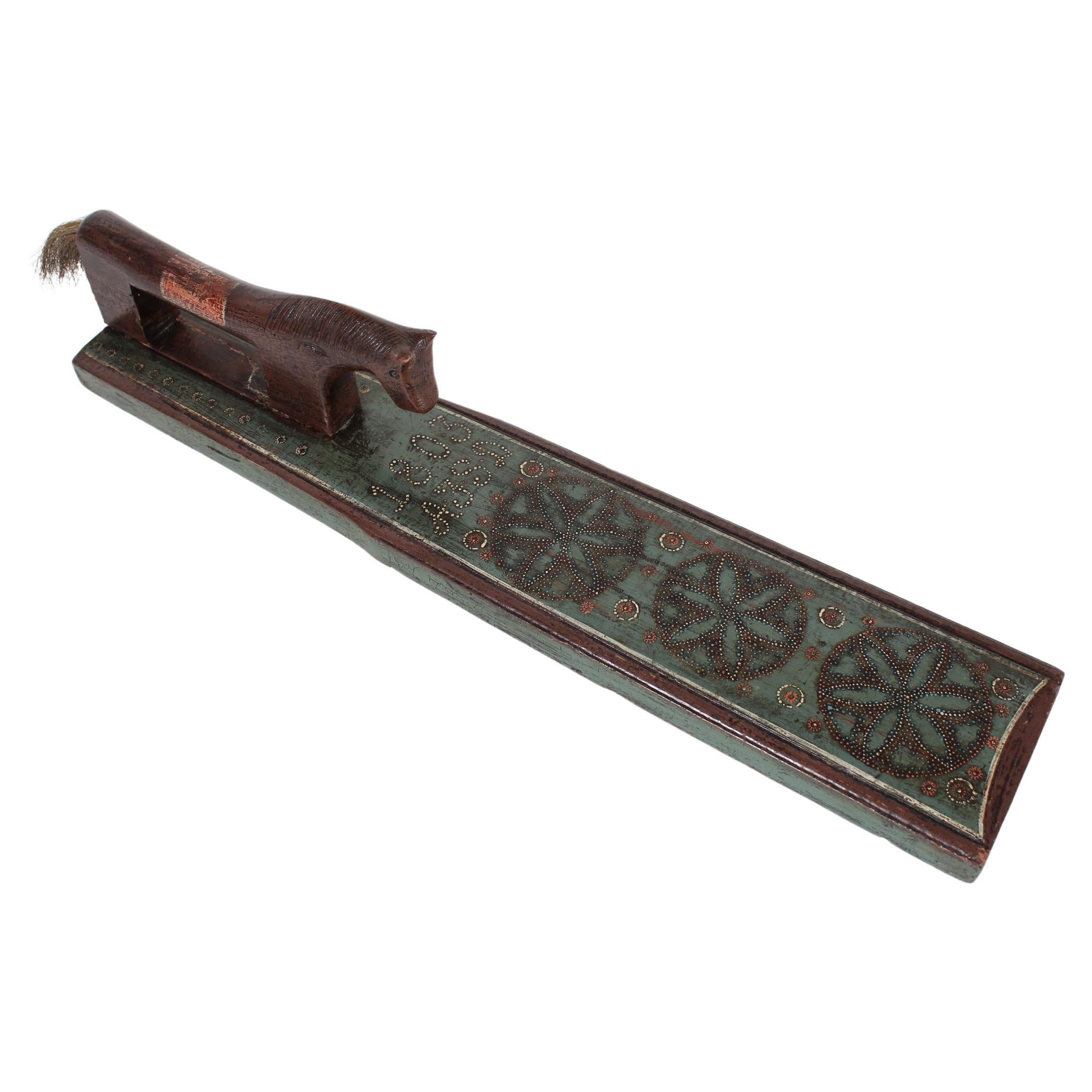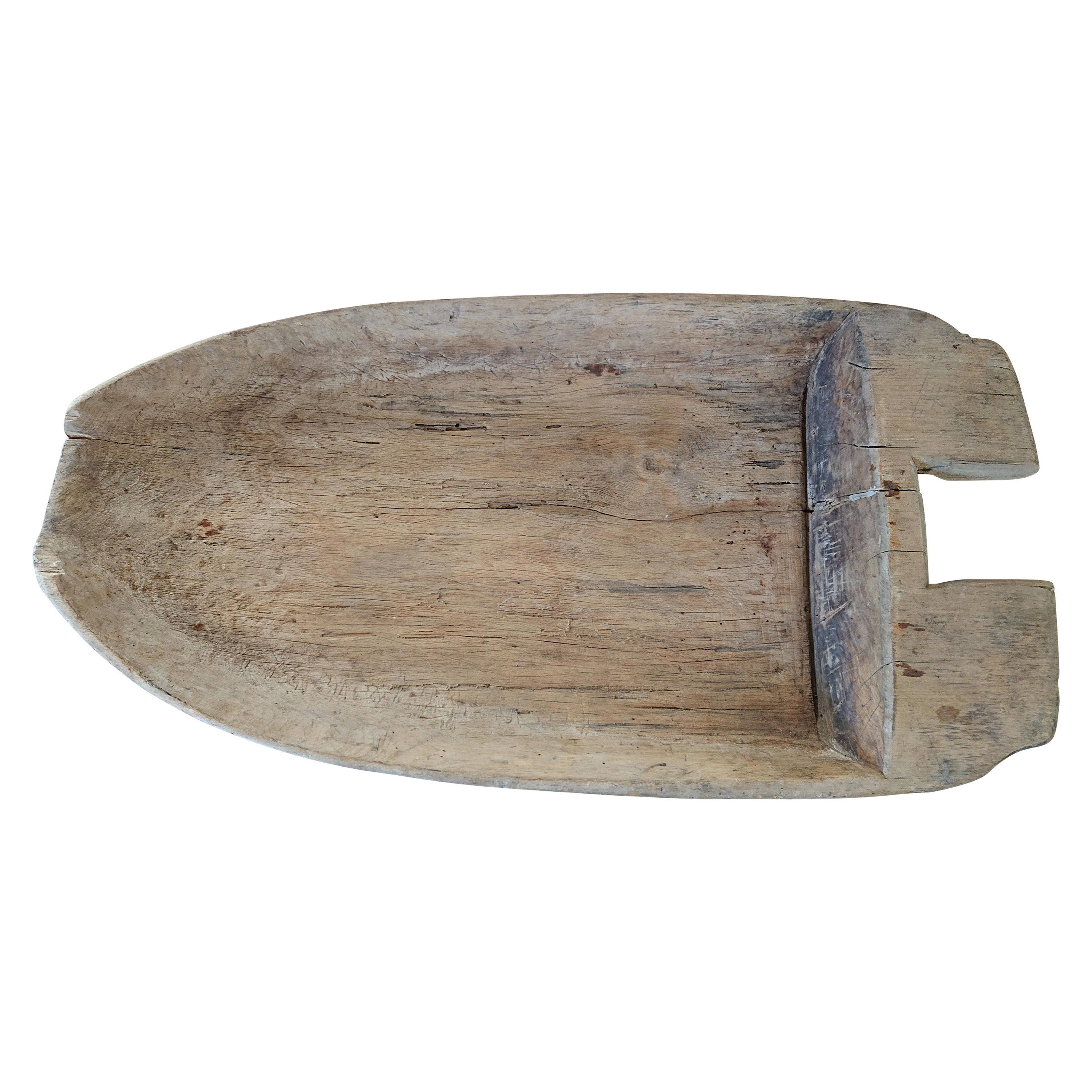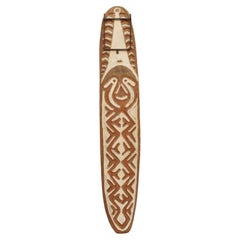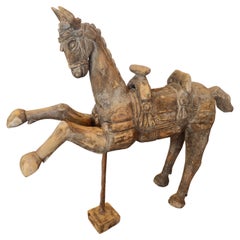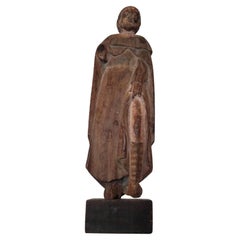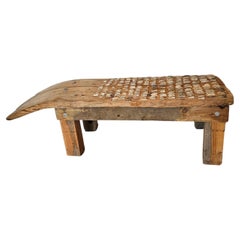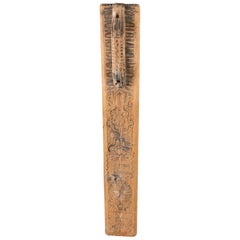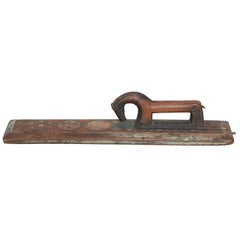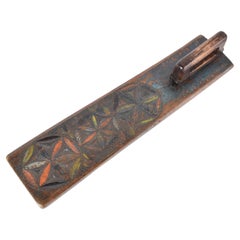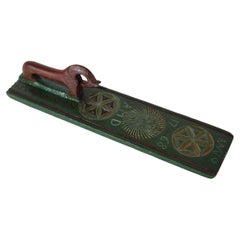Items Similar to 18th Century Swedish Carved Mangle Board
Want more images or videos?
Request additional images or videos from the seller
1 of 7
18th Century Swedish Carved Mangle Board
$2,200
£1,674.68
€1,930.49
CA$3,133.07
A$3,417.15
CHF 1,796.60
MX$41,336.30
NOK 22,419.33
SEK 21,184.13
DKK 14,412.58
About the Item
A long hand carved wooden mangle board (clothing and bedding press) with beautiful patina.
Handmade in Sweden, circa 1744, this Scandinavian antique with sculptural stylized horse handle, accented with finely incised detailing, flanked by five compass-drawn decorative circles on the single board plank.
Signed panel across center, most likey a wedding gift labeled with the two newly wed's initials, "ANOSPD" and dated 1744.
Having a richly decorated top section featuring various complex geometric pattern relief carvings focused around five large overlapping mandala style circles.
The verso with a wonderfully aged worn smooth finish, affixed with later metal bracket for wall hanging.
Provenance:
A prestigious Greenwich, CT private estate
Dimensions: (approx)
23.5" Long, 5.25" High, 6.25" Wide narrowing to 5" Wide
Museum quality condition;
This rare pre-Gustavian folk art work is in excellent shape, completely original, it's solid, sturdy and structurally sound. Enhanced by attractive patina over the whole, highly desirable well worn, naturally distressed finish, with age related splits along the ends, and minor losses to corners and edges, all wear consistent with age and use, with nothing that detracts from the overall display or functionality, but only adds to the authenticity, antique character, rustic charm and elegant warmth that can only be acquired from a life of almost three centuries.
- Dimensions:Height: 5.25 in (13.34 cm)Width: 23.5 in (59.69 cm)Depth: 6.25 in (15.88 cm)
- Style:Primitive (In the Style Of)
- Materials and Techniques:
- Place of Origin:
- Period:
- Date of Manufacture:1744
- Condition:Wear consistent with age and use. Minor losses. Excellent shape, completely original, it's solid, sturdy and structurally sound. Enhanced by attractive patina over the whole, highly desirable well worn, naturally distressed finish, with age related splits along the ends, and minor losses to corner.
- Seller Location:Forney, TX
- Reference Number:1stDibs: LU5977226683312
About the Seller
4.8
Platinum Seller
Premium sellers with a 4.7+ rating and 24-hour response times
Established in 2013
1stDibs seller since 2021
299 sales on 1stDibs
Typical response time: <1 hour
- ShippingRetrieving quote...Shipping from: Forney, TX
- Return Policy
Authenticity Guarantee
In the unlikely event there’s an issue with an item’s authenticity, contact us within 1 year for a full refund. DetailsMoney-Back Guarantee
If your item is not as described, is damaged in transit, or does not arrive, contact us within 7 days for a full refund. Details24-Hour Cancellation
You have a 24-hour grace period in which to reconsider your purchase, with no questions asked.Vetted Professional Sellers
Our world-class sellers must adhere to strict standards for service and quality, maintaining the integrity of our listings.Price-Match Guarantee
If you find that a seller listed the same item for a lower price elsewhere, we’ll match it.Trusted Global Delivery
Our best-in-class carrier network provides specialized shipping options worldwide, including custom delivery.More From This Seller
View AllLarge Oceanic Gope Carved Wooden Ancestor Spirit Board
Located in Forney, TX
An Oceanic "Gope" Papuan ancestral spirit board, 20th century, collected from the Gulf Province, Papua, New Guinea, Kerewa or Hohao village tribe.
Hand...
Category
20th Century Papua New Guinean Folk Art Sculptures and Carvings
Materials
Metal
Large Whimsical Antique Hand Carved Wooden Horse Sculpture
Located in Forney, TX
A large antique hand carved wooden horse sculpture on stand. Most likely from Southeast Asia, (Indonesian, Burmese, Thai) early 20th c...
Category
Early 20th Century Folk Art Sculptures and Carvings
Materials
Wood
17th Century Spanish Colonial Hispano-Philippine Carved Santo
Located in Forney, TX
A scarce 17th century Spanish Colonial carved wood santo with provenance from the National Museum of the Philippines Manila.
circa late 1600s
A large part of what makes this example so very rare is not just the age and condition, but the saint depicted, San Roque.
The Hispano-Philippine (Spanish-Filipinos) hand carved hard wood religious altar figure presents splendidly, with scattered remnants of original gesso and polychrome pigments, the exceptionally sculpted religious folk art depicting San Roque (Saint Roch or Rocco), the 14th century Catholic patron saint frequently invoked against the plaque, various infectious disease, as well as patron saint of dogs, invalids, of falsely accused people, and of bachelors, amongst others.
Provenance / Acquisition:
Retaining registration - identification label to verso from The Republic of the Philippines (RP) National Museum of the Philippines Manila with hand written registration number.
Acquired from highly reputable auction house, Austin Auction Gallery, est. 1982, Austin, Texas. February 2022 catalog.
Dimensions: (approx)
Overall: 15.75" High, 5" Wide, 4" Deep.
Figure: 14" High
1.5lbs
Great original antique condition, especially considering it's around 350 years old. Nicely aged patina over the whole. Presented on a later wood plinth base. Typical loss to right arm, minor finish losses, old tiny metal plate added to prevent age related splitting, all wear consistent with age, and only adds to the overall sophisticated character, authenticity, and charming rustic warmth that can only be acquired over long periods of time.
We here at Lynx Hollow Antiques absolutely love religious antiques, from an antique altar, church architectural salvaged building and ornamental elements, reliquary, tabernacle cabinet...
Category
Antique 17th Century Spanish Colonial Religious Items
Materials
Gesso, Hardwood
Antique Mediterranean Farm Threshing Board Primitve Tribulum Bench or Table
Located in Forney, TX
A most impressive antique Mediterranean threshing board repurposed as a bench or coffee table.
This 19th century thresing board, also known as threshing sledge...
Category
Antique 19th Century European Industrial Benches
Materials
Stone
Antique Swedish Gustavian Period Rustic Country Farmhouse Pine Cradle Bin
Located in Forney, TX
A scarce Gustavian Period (1772-1809) country Swedish farmhouse hand carved pine rocking cradle / bassinet for decorative use only (today, it could be repurposed as a wonderful firew...
Category
Antique Late 18th Century Swedish Gustavian Sculptures and Carvings
Materials
Pine
19th Century French Carved Walnut Sewing Work Stand Quilt Rack
Located in Forney, TX
A rare and unusual antique circa 1870s French trestle-form sewing work stand / quilt rack with beautifully aged heavily worn patina.
France, late 19th ce...
Category
Antique Late 19th Century French Rococo Side Tables
Materials
Upholstery, Walnut
You May Also Like
18th Century Swedish Decorated Mangle Board
Located in Kramfors, SE
Folk art mangle board from northern Sweden. This is a typical proposal gift to the would-be bride from the groom. If he had the skill the groom would make...
Category
Antique Late 18th Century Swedish Folk Art Antiquities
Materials
Pine
Early 19th Century Scandinavian Folk Art Mangle Board
Located in Greenwich, CT
Charming early 19th Century Swedish folk art mangle board having a stylized horse handle, the body with geometric carving and traces of original polychrom...
Category
Antique 19th Century Swedish Folk Art Sculptures
Materials
Wood
Antique Danish 1841 Mangle Board Wedding Love Gift Colorful Hand-Carved Wood
Located in Silkeborg, Silkeborg
Antique Danish or Scandinavian mangle board (clothing and bedding press) dated 1941. It has this text cut into it: KM JDR 1841 and a short text painted on both sides of the handle. I...
Category
Antique 1840s Scandinavian Folk Art Wall-mounted Sculptures
Materials
Wood
Antique Danish Wooden Mangle Board Wedding Love Gift with Horse Dated 1768
Located in Silkeborg, Silkeborg
Danish mangle board (clothing and bedding press) dated 1768.
Made of wood richly decorated with hand-carved geometric patterns and a horse as handle. With original brown, green and ...
Category
Antique 1760s Scandinavian Folk Art Wall-mounted Sculptures
Materials
Wood
Antique Danish Mangle Board Wedding Love Gift Painted Wood, Horse Handle, 1803
Located in Silkeborg, Silkeborg
Antique Danish mangle board (clothing and bedding press) dated 1803.
It is made from oak wood which is hand carved with a rich decoration of geometric blossoms. Painted in the colou...
Category
Antique Early 19th Century Scandinavian Folk Art Wall-mounted Sculptures
Materials
Wood
18th Century Swedish Folk Art Wooden Cheese Board from Northern Sweden
Located in Boden, SE
18th century Swedish Folk Art Wooden cheese board from, Northern Sweden
A tray with lovely patina.
It has owner marks SOS on the side of the board.
A large farmers Cheese board o...
Category
Antique Mid-19th Century Swedish Folk Art More Folk Art
Materials
Pine
More Ways To Browse
Antique Wedding Gift
Antique 18Th Century Primitives
Antique Metal Brackets
Primitive Swedish
Antique Mangler
Antique Mangles
Antique Metal Wall Hanging
Mangle Board
Swedish Mangle
Mexican Wood Carving
Swedish Dala
Antique Mangler
Antique Mangles
Santos Carvings
Cookie Mold
Human Effigies
Wood Carved Gnome
Dala Horse
